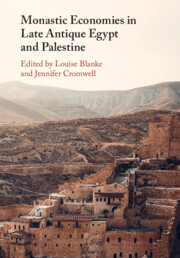Book contents
- Monastic Economies in Late Antique Egypt and Palestine
- Monastic Economies in Late Antique Egypt and Palestine
- Copyright page
- Contents
- Figures
- Tables
- Contributors
- Preface
- 1 The Monastic Economies in Late Antique Egypt and Palestine: Past, Present, and Future
- I. The Monastic Estate
- II. Production and Consumption of Food and Material Goods
- III. Monastic Encounters: Travel, Pilgrimage, and Donations
- 10 Distinguishing Offerings from Blessings in Early Byzantine Monasticism: The Significance of P.Ness. III 79 (ca. 600 AD)
- 11 Staple for Body and Soul: Working at and Visiting the Upper Egyptian Monastery Deir Anba Hadra
- 12 The Monastic Landscape of Mount Nebo: An Economic Pattern in the Province of Arabia
- 13 Travel in the Texts: Monastic Journeys in Late Antique Egypt
- Glossary
- Index
- References
12 - The Monastic Landscape of Mount Nebo: An Economic Pattern in the Province of Arabia
from III. - Monastic Encounters: Travel, Pilgrimage, and Donations
Published online by Cambridge University Press: 14 April 2023
- Monastic Economies in Late Antique Egypt and Palestine
- Monastic Economies in Late Antique Egypt and Palestine
- Copyright page
- Contents
- Figures
- Tables
- Contributors
- Preface
- 1 The Monastic Economies in Late Antique Egypt and Palestine: Past, Present, and Future
- I. The Monastic Estate
- II. Production and Consumption of Food and Material Goods
- III. Monastic Encounters: Travel, Pilgrimage, and Donations
- 10 Distinguishing Offerings from Blessings in Early Byzantine Monasticism: The Significance of P.Ness. III 79 (ca. 600 AD)
- 11 Staple for Body and Soul: Working at and Visiting the Upper Egyptian Monastery Deir Anba Hadra
- 12 The Monastic Landscape of Mount Nebo: An Economic Pattern in the Province of Arabia
- 13 Travel in the Texts: Monastic Journeys in Late Antique Egypt
- Glossary
- Index
- References
Summary
This chapter examines the economic pattern of the monastery built around the Memorial of Moses on Mount Nebo in the Roman province of Arabia (modern Jordan). After a topographical introduction of the site’s landscape and its physical environment, the agricultural production strategies of the monastic complex are taken into consideration. On one hand, particular attention is paid to the production facilities found in the monastery, such as wine presses and ovens for the preparation of bread, and on the other hand to the traces of agricultural tillage, the management of water resources, and religious and lay patronage. The analysis of seeds and palaeobotanical remains found in the latest archaeological excavations allow us to reflect on the possible diet of the monks and, consequently, on the crops grown in the monastic fields of the Nebo region.
Keywords
- Type
- Chapter
- Information
- Monastic Economies in Late Antique Egypt and Palestine , pp. 334 - 358Publisher: Cambridge University PressPrint publication year: 2023

